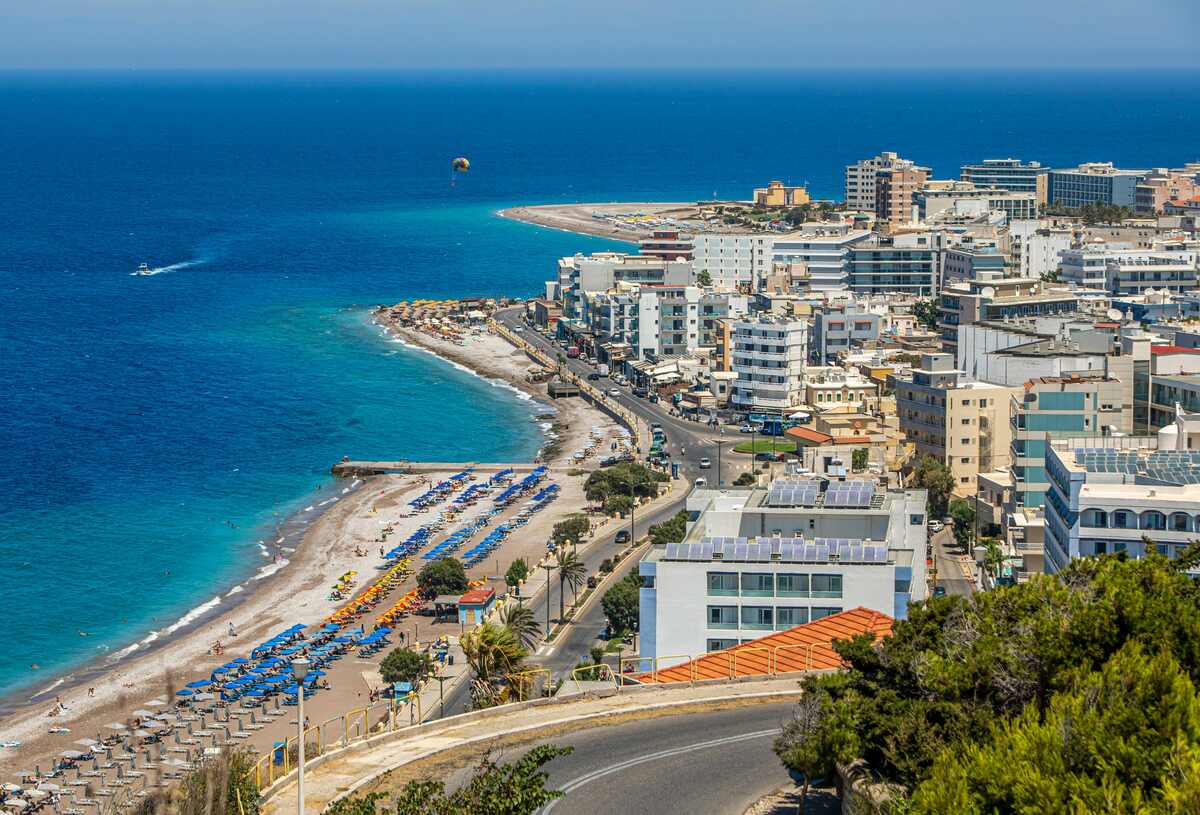
Protaras hosts 15 stunning beaches along a 10-kilometre stretch of Cyprus’s southeast coast, with Fig Tree Bay ranking consistently as one of Europe’s finest beaches. This quieter alternative to neighbouring Ayia Napa combines exceptional golden sand beaches, crystal-clear shallow waters, comprehensive family-friendly facilities, and a more relaxed atmosphere that appeals particularly to families and couples seeking quality coastal experiences without intense party scenes.There’s something rather special about Protaras that doesn’t always translate through photographs or descriptions. The area lacks Ayia Napa’s fame and consequently attracts fewer crowds, yet the beach quality matches—and sometimes exceeds—its more famous neighbour. It’s quieter without being dull, developed without feeling overdone, and maintains this pleasant balance between offering comprehensive facilities whilst preserving a relatively laid-back Mediterranean atmosphere.
This comprehensive guide explores every significant beach in Protaras, what makes this coastal area particularly appealing, and honestly, why it deserves consideration as your base for exploring Cyprus’s top beaches. We’ve spent considerable time in Protaras across multiple visits, and it consistently delivers perhaps the most balanced beach holiday experience on the island.
Understanding Protaras as a Destination
Protaras sits on Cyprus’s southeast coast, adjacent to Ayia Napa but maintaining a distinctly calmer, more family-oriented character. The resort area stretches approximately 10 kilometres along the coastline, with beaches connected by a scenic coastal promenade perfect for walking and cycling.
Protaras emerged as a resort area more recently than Ayia Napa, developing primarily from the 1990s onwards. This later development meant planners could learn from other areas’ mistakes—the result is a resort that feels more thoughtfully designed with wider streets, better spacing between buildings, and more green spaces. It’s not dramatically different from Ayia Napa in appearance, but there’s a slightly more ordered, spacious feel to the place.
The demographic differs noticeably from Ayia Napa. Protaras attracts predominantly families and couples rather than large groups seeking party atmospheres. This affects everything—restaurant styles, entertainment options, beach atmospheres, even shop offerings. You’ll find fewer nightclubs and more family restaurants, fewer beach parties and more calm swimming areas, fewer shops selling party accessories and more selling beach toys and family necessities.
The coastal promenade deserves particular mention. Well-maintained, mostly flat, and offering sea views throughout, it connects most major beaches and creates pleasant walking or cycling opportunities. Many visitors enjoy evening promenade walks after dinner—it’s become something of a Protaras tradition, with the path filling with families, couples, and groups enjoying the cooler evening air whilst watching the Mediterranean under moonlight.
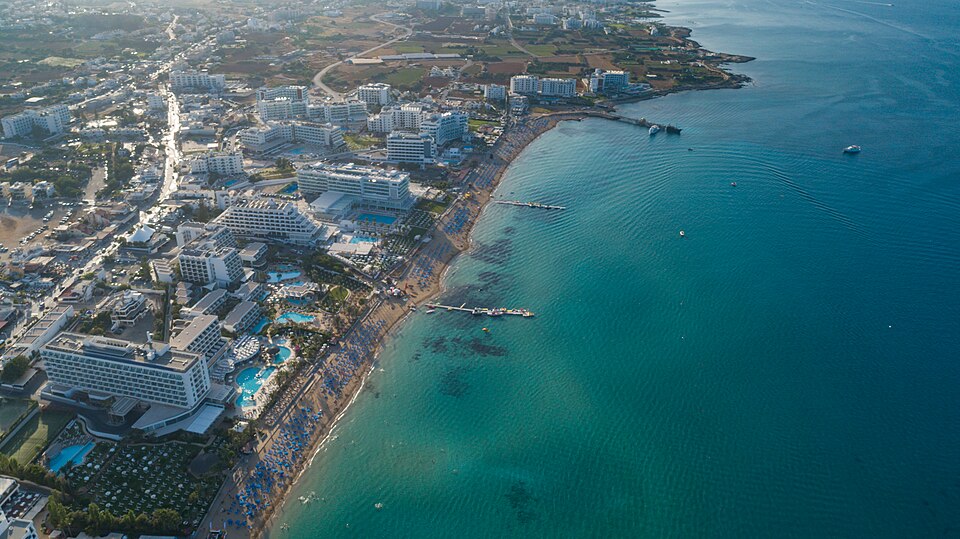
Fig Tree Bay: The Crown Jewel
Fig Tree Bay consistently ranks among Europe’s top beaches, featuring exceptionally shallow calm waters extending 30+ metres from shore, fine golden sand, a small offshore island reachable by swimming, and comprehensive facilities including lifeguards, clean amenities, and numerous restaurants. The beach has won multiple international awards and maintains Blue Flag status year after year.
If Protaras has one genuinely famous beach, it’s Fig Tree Bay. And unlike some famous beaches that don’t quite live up to their reputations, Fig Tree Bay absolutely delivers. The sand is exceptionally fine—almost powdery—and that attractive golden colour that photographs beautifully. The water achieves remarkable clarity, that distinctive turquoise that Cyprus beaches are known for, and you can see the sandy bottom even when you’re waist-deep.
What makes Fig Tree Bay particularly special, I think, is how the shallow water extends so far from shore. You can wade out perhaps 25-30 metres whilst still standing comfortably. This creates an enormous area where children can play safely, nervous swimmers can gain confidence, and everyone can enjoy water activities without depth concerns. It’s genuinely unusual to find such extensive shallow areas at quality beaches—usually, you get steep drop-offs or rocky bottoms, but Fig Tree Bay offers perfect conditions.
That small island sitting perhaps 70 metres offshore—officially called Nisida but everyone just calls it “the island”—captures imaginations brilliantly. During calm conditions, which describes most summer days, swimming to the island is perfectly manageable for modest swimmers. Children particularly love this adventure—swimming out, standing on the rocks, waving to parents on the beach, feeling genuinely accomplished. It’s the sort of beach memory that sticks with people for years.
Fig Tree Bay’s Name and History
Fig Tree Bay derives its name from a solitary fig tree that historically grew near the beach, though the specific tree that inspired the name no longer stands. The area’s development as a tourist destination began in the 1970s, with major expansion occurring through the 1990s and 2000s.
The original fig tree that gave the bay its name apparently grew close to the shore, providing shade for fishermen and locals who used the beach before tourism development. Whilst that specific tree is gone, several fig trees grow in the area now, maintaining the connection to the name even if the historical accuracy is somewhat tenuous. It’s a more romantic name than many beaches receive, certainly more memorable than “Beach Number Three” or similar uninspired options.
Fig Tree Bay Facilities and Practical Information
Fig Tree Bay provides sunbed rentals (€7.50 per set daily), parasol hire, clean toilet and shower facilities, changing rooms, lifeguard supervision throughout summer (10am-6pm), beach volleyball courts, and water sports including pedal boats, kayaks, and paddleboards. Multiple restaurants within 50 metres offer diverse dining options.
The facilities at Fig Tree Bay are genuinely comprehensive. Sunbed hire is straightforward—operators work the beach offering standard rates, and you can usually negotiate slightly if you’re renting for multiple days. The sunbeds are comfortable, properly maintained, and positioned with enough spacing that you don’t feel crammed against neighbours even when the beach is busy.
Toilets and showers are properly maintained—this might seem like a minor detail, but after visiting beaches with inadequate facilities, you genuinely appreciate clean, functioning amenities. They’re conveniently located at several points around the bay, meaning you’re never more than perhaps 100 metres from facilities. This matters enormously, particularly if you’re visiting with children who announce urgent bathroom needs without much warning.
Lifeguards operate throughout summer months, positioned to monitor the main swimming areas effectively. They’re professional, alert, and equipped with modern rescue equipment. The beach holds Blue Flag status, confirming it meets strict international standards for water quality, safety equipment, environmental management, and facility maintenance. For family beaches, this designation provides reliable quality assurance.
Water sports at Fig Tree Bay tend towards calmer activities compared to Ayia Napa beaches. You’ll find pedal boats, kayaks, stand-up paddleboards, and similar options rather than jet skis and parasailing. This reflects the family-oriented character—activities that everyone can enjoy rather than adrenaline-focused options. Prices are reasonable: pedal boats around €15 per hour, kayaks €10-15 per hour, paddleboard hire €15-20 per hour.
When to Visit Fig Tree Bay
Visit Fig Tree Bay early morning (before 9am) for quieter conditions and securing prime positioning, or choose September when weather remains excellent but crowds significantly reduce after European school terms restart. June offers another ideal window balancing warm weather with manageable visitor numbers.
Fig Tree Bay gets busy—there’s no way around this fact. Its reputation as one of Europe’s best beaches means it attracts considerable attention during summer months. July and especially August see the beach reach capacity by mid-morning, with every sunbed occupied and sand space at premium. If you’re visiting during peak season and want good positioning, arriving by 9am—earlier is even better—makes sense.
September stands out as perhaps the optimal month for Fig Tree Bay. The sea has retained summer warmth at around 26°C, air temperatures moderate slightly to 28-30°C, and once schools restart across Europe, tourist numbers drop noticeably. The beach never becomes completely empty—it’s too good for that—but you can arrive at 10am and still find decent spots, which is essentially impossible during July-August.
Early mornings at Fig Tree Bay offer genuinely lovely experiences. The sand is pristine from overnight cleaning, the water glass-calm before breezes pick up, and you might have entire sections nearly to yourself. There’s something rather magical about watching the sun illuminate the bay whilst swimming in perfectly clear water with hardly anyone else around. It’s a completely different beach from the midday crowds.
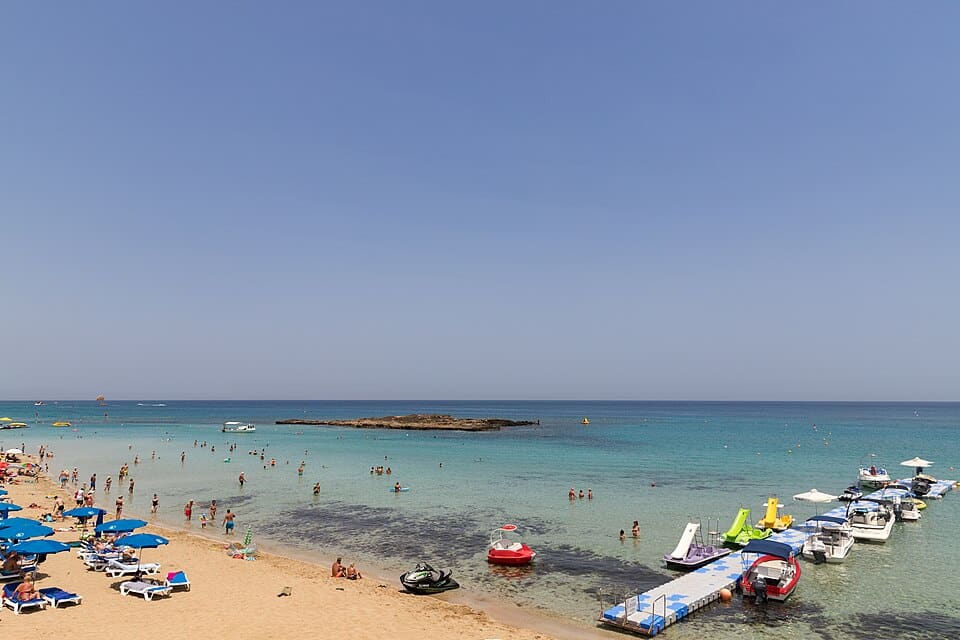
Green Bay: The Quieter Alternative
Green Bay, located immediately south of Fig Tree Bay, offers similar conditions—shallow calm waters, soft golden sand, good facilities—with notably fewer crowds. The beach provides excellent quality for visitors seeking slightly more peaceful alternatives whilst maintaining the standards Protaras beaches are known for.
Green Bay sits perhaps 300 metres south of Fig Tree Bay, easily walkable via the coastal promenade. The beach delivers comparable sand quality—fine, golden, clean—and the water is equally clear and shallow. Facilities are perfectly adequate if not quite as comprehensive as Fig Tree Bay. What Green Bay lacks in fame, it compensates for with space. Even during busy periods, Green Bay rarely reaches Fig Tree Bay’s crowd density.
The beach earned its name from the surrounding vegetation rather than water colour, though the water is indeed beautifully green-blue. Pine trees grow close to the beach, providing natural shade that becomes genuinely valuable during peak summer heat. Being able to position yourself under trees rather than relying entirely on parasols is pleasant, and the shade remains consistent throughout the day unlike umbrella shade which shifts as the sun moves.
What I particularly appreciate about Green Bay is how it works for different groups. Families cluster at one end where the water stays particularly shallow and calm. Couples often prefer the quieter southern section. Snorkelling enthusiasts gravitate towards the rocky northern edges where you’ll find more interesting underwater features. The beach is large enough that everyone finds their preferred spot without feeling cramped.
Snorkelling at Green Bay
Green Bay’s rocky northern section provides decent snorkelling opportunities with various fish species, sea urchins, and occasionally octopuses visible in clear waters. The conditions suit beginners whilst offering enough interest for experienced snorkellers.
The rocky areas around Green Bay’s edges harbour more diverse marine life than the sandy central sections. Bring snorkelling gear and you’ll spot various fish species including colourful wrasse, damselfish, and occasional sea bream. Sea urchins cling to rocks—they’re not dangerous if you’re careful, just watch where you’re putting your hands and feet. If you’re observant and lucky, you might spot octopuses tucked into rocky crevices, though they’re masters of camouflage.
The water clarity makes snorkelling particularly rewarding. Visibility extends for many metres on calm days, allowing you to spot fish and features from considerable distance. This is proper snorkelling—not just swimming with a mask—but accessible enough for families with older children who are comfortable in water.
Konnos Bay: The Scenic Beauty
Konnos Bay, positioned between Protaras and Ayia Napa, offers Protaras’s most dramatic setting with pine-covered cliffs surrounding a sheltered bay, exceptional snorkelling around rocky formations, and a quality taverna serving fresh seafood. The bay combines natural beauty with excellent facilities, creating one of Cyprus’s most memorable beach experiences.
Konnos Bay occupies a rather unique position—geographically sitting on the boundary between Protaras and Ayia Napa, and aesthetically representing a middle ground between developed resort beaches and wild coastal areas. The bay is tucked into the coastline, surrounded by limestone cliffs that plunge dramatically to meet turquoise water. Dense pine forest covers the surrounding hills, creating a scenic backdrop that feels more rugged than typical east coast beaches.
The setting is genuinely picturesque—the sort of place that looks stunning even in mediocre photographs, and spectacular in good ones. Those dramatic cliffs, the deep blue-green water, the pine trees reaching almost to the sand—it combines into scenery that many visitors cite as their favourite beach view from Cyprus holidays. I think what makes it special is how the natural elements frame the bay, creating this sense of discovery despite the beach being easily accessible and well-facilitated.
Konnos Bay’s Underwater World
Konnos Bay provides Protaras’s best snorkelling with rocky underwater formations, diverse marine life, small caves, and exceptional water clarity typically exceeding 20 metres visibility. The bay’s sheltered position ensures calm conditions most days, making it suitable for novice snorkellers whilst offering enough interest for experienced enthusiasts.
What distinguishes Konnos from standard swimming beaches is the underwater environment. The bay’s centre features sandy bottom ideal for swimming and general beach activities, but around the edges, particularly along the northern and southern rocky sections, you’ll discover surprisingly rich marine life. Various fish species inhabit these areas—wrasse in multiple colours, damselfish darting between rocks, occasional parrotfish, and if you’re lucky, small groupers hiding in crevices.
Small caves around the bay’s edges appeal to adventurous swimmers. These aren’t massive cave systems—more like rocky overhangs and shallow indentations—but they’re fun to investigate carefully. You’ll want to be cautious of currents near cave entrances, and obviously only explore if you’re a confident swimmer. But for those comfortable in water, they add an element of underwater exploration that standard beach swimming lacks.
The water clarity here consistently impresses. On calm days—which the bay’s sheltered position ensures frequently—underwater visibility extends for 20+ metres. This creates ideal conditions for snorkelling, underwater photography, and simply swimming with your eyes open. There’s something rather wonderful about being able to see so clearly underwater; it removes that slightly anxious feeling of not knowing what’s beneath you.
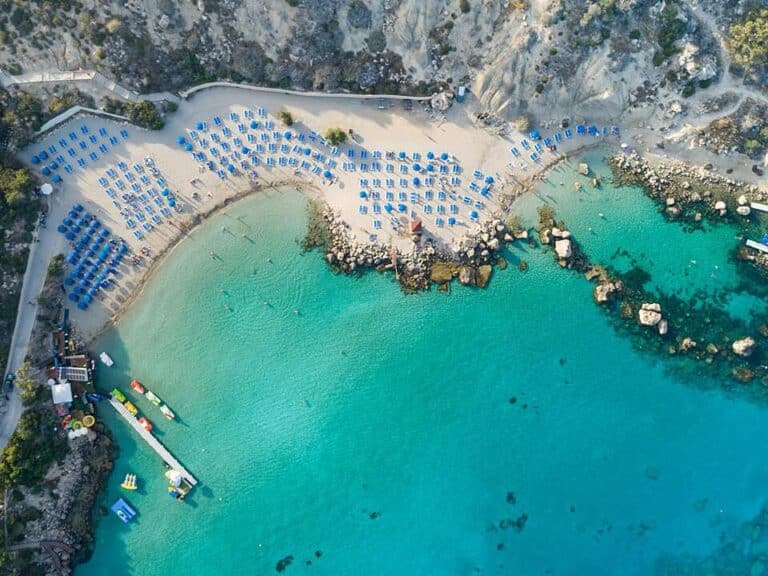
Konnos Bay Taverna
Konnos Bay Taverna, family-run and positioned overlooking the bay, serves genuinely excellent fresh fish and traditional Cypriot dishes at reasonable prices. The setting and food quality make it one of Protaras’s best beachside dining options.
The taverna deserves specific mention because it elevates the Konnos Bay experience considerably. It’s family-run, clearly taking pride in food quality rather than coasting on location convenience. The fresh fish is genuinely fresh—you can often see fishing boats delivering catches early morning. Traditional Cypriot dishes are prepared authentically, and service is warm and efficient without being rushed.
The setting, overlooking the bay from a slightly elevated position, is lovely. You can have lunch whilst watching the beach and sea, perhaps with a cold beer or glass of local wine, and genuinely savour the moment. Prices are reasonable—certainly less than tourist-heavy restaurants in central Protaras or Ayia Napa. A proper lunch here, perhaps with fresh sea bream or calamari, enhances the day considerably beyond just beach time.
Pernera Beach: The Local Favourite
Pernera Beach attracts more local Cypriot families than international tourists, creating authentic atmosphere whilst maintaining good facilities, safe swimming conditions, and a pleasant promenade lined with traditional tavernas. The beach offers genuine local flavour rarely found at major resort beaches.
Pernera sits slightly north of central Protaras, retaining a more village-like feel despite tourism development. The beach itself is pleasant—golden sand, clear water, adequate facilities—but what makes it special is the demographic. You’ll encounter Cypriot families, particularly during weekends and evenings when locals head to the beach after work. This creates different dynamics that some visitors find refreshing after days at tourist-dominated beaches.
The atmosphere is noticeably more relaxed and genuine. You’re not constantly marketed to—fewer water sports operators, beach sellers, activities coordinators. Instead, you get proper beach experience focused on swimming, sunbathing, and socialising. Children play in shallow water whilst parents chat with neighbours, extended families set up elaborate beach camps with coolers and umbrellas, and there’s this pleasant sense of community rather than anonymous tourism.
Pernera Promenade
The Pernera promenade extends for approximately 2 kilometres, connecting several beaches and featuring traditional tavernas, cafés, playgrounds, and scenic sea views. Evening promenade walks have become a beloved local tradition, with families and visitors enjoying cooler temperatures whilst watching the Mediterranean.
The promenade provides excellent walking, particularly during evenings when it’s too late for beach time but too early for bed. Families with children appreciate the several playgrounds positioned along the route—convenient for burning off excess energy after dinner. The tavernas and cafés offer stopping points, many with sea-view terraces perfect for watching the sunset whilst enjoying drinks or dessert.
What I find appealing about evening promenade walks is how they’ve become this shared activity that both locals and visitors participate in. There’s something rather pleasant about this democratic use of public space—everyone walking, chatting, enjoying the evening regardless of nationality or socioeconomic status. It creates moments of genuine cultural exchange that purely tourist environments rarely offer.
Vrisi Beach: The Hidden Gem
Vrisi Beach, tucked between larger beaches north of Protaras centre, offers quiet conditions, shallow waters, and basic facilities whilst maintaining Protaras’s characteristic sand quality and water clarity. The beach provides peaceful alternatives for visitors seeking escape from busier locations.
Vrisi Beach doesn’t appear in most tourist guides, which explains its relative tranquillity. The beach is small—perhaps 150 metres of coastline—and facilities are basic, but the essentials are present. What you won’t find are crowds, aggressive water sports marketing, or beach bars playing loud music. What you will find is pleasant golden sand, clear shallow water, and space to simply enjoy beach time without constant stimulation or noise.
The beach’s small size creates an intimate atmosphere that some visitors prefer over sprawling beaches where you might feel lost among thousands of people. You can often recognise the same faces across multiple days, perhaps strike up conversations, share beach space in that companionable way that happens at smaller beaches. It’s not dramatically better quality than other Protaras beaches—the sand, water, and conditions are comparable—but the scale and atmosphere differ noticeably.
Sunrise Beach: Living Up to Its Name
Sunrise Beach, located at the eastern edge of Protaras near Cape Greco, offers spectacular sunrise views across the Mediterranean, rocky swimming areas popular with snorkellers, and a more natural setting than central Protaras beaches. The beach appeals to early risers and visitors seeking dramatic coastal scenery.
The name isn’t just marketing—sunrise views from this beach are genuinely spectacular. The eastern orientation means you’re watching the sun emerge directly from the Mediterranean, and during summer months when the sun rises around 6am, you might catch dramatic displays of colour washing across the sky and water. It’s the sort of scene that makes waking early worthwhile, particularly for photography enthusiasts or simply those who appreciate natural beauty.
The beach itself is rockier than central Protaras beaches—less golden sand, more rock platforms and pebbled sections. This makes it less ideal for traditional beach activities like sandcastle building or beach volleyball, but the rocky environment supports better snorkelling with more diverse marine life than sandy beaches typically harbour. It’s a different type of beach experience—more about swimming, snorkelling, and coastal scenery than lounging on soft sand.
Water Sports in Protaras
Protaras beaches offer family-oriented water sports in Cyprus including kayaking (€10-15 per hour), stand-up paddleboarding (€15-20 per hour), pedal boats (€15 per hour), and snorkelling equipment rental (€10 per day). Activities emphasise accessible options suitable for all ages rather than adrenaline-focused extremes.
The water sports character in Protaras differs noticeably from Ayia Napa. Rather than jet skis and parasailing dominating, you’ll find more emphasis on kayaking, paddleboarding, and similar activities that families can enjoy together. This reflects the area’s overall family-oriented character—activities designed for participation rather than spectating, suitable for varied fitness levels, and emphasising fun over adrenaline.
Kayaking particularly appeals to many visitors. You can rent single or double kayaks and explore the coastline at your own pace, perhaps paddling to quiet coves, investigating rocky areas, or simply enjoying water time from a different perspective. It’s genuine activity rather than passive sunbathing, but accessible enough that most people can participate regardless of athletic ability.
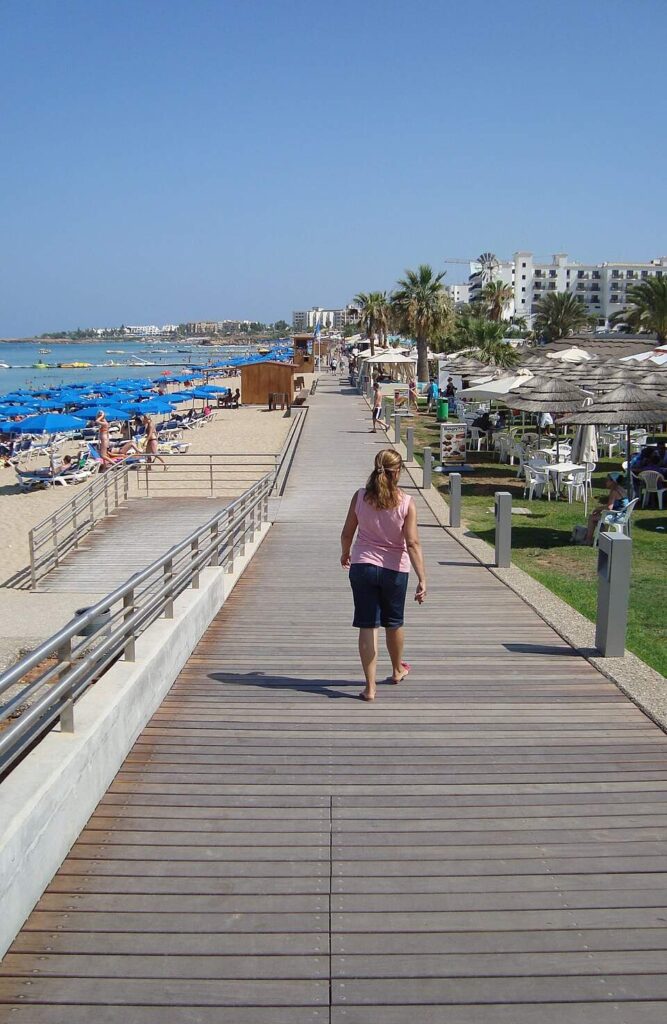
Protaras Beach Promenade and Coastal Path
The Protaras coastal promenade and path extend approximately 6 kilometres, connecting major beaches from Pernera in the north to Konnos Bay in the south. Well-maintained, mostly flat, and offering continuous sea views, the path creates excellent walking and cycling opportunities whilst providing access to numerous beaches, restaurants, and viewpoints.
The coastal path represents one of Protaras’s genuine assets. Well-paved, properly maintained, with regular benches and viewpoints, it makes exploring multiple beaches genuinely pleasant rather than requiring constant driving. You can walk from your accommodation to various beaches, perhaps trying different locations across multiple days, stopping at cafés and restaurants along the way. It’s the sort of infrastructure that enhances destinations considerably but often goes unappreciated until you’ve experienced areas lacking such facilities.
Cycling the path is particularly popular—many hotels offer bicycle rental, and the mostly flat terrain makes cycling accessible for varied fitness levels. An early morning cycle from Pernera to Konnos Bay, perhaps stopping for coffee at a beachside café, then swimming at Konnos before returning, creates a lovely morning that combines exercise, scenery, and beach time.
Best Times to Visit Protaras Beaches
September and June offer optimal Protaras beach conditions with warm temperatures (26-30°C), pleasant sea temperatures (24-26°C), and significantly reduced crowds compared to July-August peak season. May provides excellent conditions for budget-conscious visitors, whilst October extends the season for those seeking quiet late-season beach holidays.
Peak season—July and especially August—delivers guaranteed hot weather but also maximum crowds at popular beaches like Fig Tree Bay. Temperatures regularly exceed 33°C, which some visitors find uncomfortably hot, particularly for extended beach days. Beaches reach capacity by mid-morning, restaurant bookings become necessary, and prices peak. If you thrive in busy, energetic summer environments and want guaranteed hot weather, peak season delivers. But if crowds stress you or heat bothers you, shoulder season offers better overall experiences.
September stands out as perhaps the ideal month for Protaras. The sea has retained summer warmth at around 26°C—genuinely comfortable, feeling almost bathwater-warm—whilst air temperatures moderate slightly to 28-30°C. Once European schools restart, tourist numbers drop dramatically, yet facilities continue operating normally. Beaches feel spacious again, restaurant service becomes more relaxed, and the overall atmosphere shifts from hectic to pleasant without losing summer beach conditions.
June offers another excellent window, particularly early June before schools break for summer. Weather is reliably warm—around 28-32°C—the sea is comfortable at 23-25°C, and crowds haven’t yet reached peak levels. Prices remain lower than July-August, and hotels often offer better availability. The experience feels more relaxed whilst still delivering proper summer beach conditions.
May appeals to budget-conscious visitors and those who don’t mind slightly cooler water. The sea averages around 20-22°C—refreshing rather than warm, but perfectly swimmable if you’re not particularly cold-sensitive. Air temperatures reach pleasant 25-28°C, wildflowers bloom across Cyprus creating beautiful scenery, and prices drop considerably from peak season. It’s proper beach weather, just not quite the intense heat some visitors seek.
Getting to and Around Protaras Beaches
Most Protaras beaches are accessible via the coastal promenade on foot, by local bus (routes 101, 102 serve main beaches), or by taxi (€5-8 from central Protaras). Car rental provides maximum flexibility for exploring Cape Greco and more remote beaches, though central beaches don’t require vehicles.
Walking between beaches is genuinely practical in Protaras thanks to the coastal path. From central Protaras to Fig Tree Bay takes perhaps 15 minutes, to Konnos Bay about 45 minutes. These aren’t particularly strenuous walks—the path is mostly flat, well-shaded in sections, and you’re always beside the sea. Many visitors walk to one beach, spend the day there, then taxi back if they’re tired—combining exercise with convenience.
Local buses operate regularly during summer, running routes specifically servicing beaches. Fares are inexpensive—€1.50 per journey—and buses are air-conditioned, providing welcome relief during hot weather. Timetables are available at hotels and online, and the service is reliable during peak season, though frequency reduces considerably outside summer months.
Hiring a car makes sense if you’re planning to explore Cape Greco National Park or visit beaches further afield. It’s not necessary for accessing main Protaras beaches, but the flexibility allows spontaneous trips to different areas. Parking is generally available at beaches, either in designated car parks or along access roads, though arriving early secures spaces more easily during peak season.
Accommodation Considerations for Protaras
Choose Protaras accommodation based on proximity to preferred beaches, with central locations offering walking access to Fig Tree Bay and Green Bay, whilst northern Protaras (Pernera area) provides quieter environments with more local character. Self-catering apartments offer flexibility for families, whilst hotels provide comprehensive facilities including pools and restaurants.
Location matters considerably in Protaras. Central locations—within perhaps 10-15 minutes’ walk of Fig Tree Bay—provide easiest beach access and most restaurant choices, but can feel busier and more tourist-oriented. Northern areas around Pernera offer more authentic atmosphere and often better value, though beach access requires slightly more effort. Southern locations near Konnos Bay combine natural beauty with relative tranquillity but are further from main facilities.
Self-catering apartments provide genuine value for longer stays and families. Having kitchen facilities means you can prepare familiar breakfasts, snacks, and simple meals, which saves money and offers flexibility when restaurant meals feel like too much effort. Many apartments also include multiple bedrooms and living space, creating more comfortable accommodation for families than single hotel rooms.
Hotels offer comprehensive facilities—pools, restaurants, bars, animation programmes—that appeal particularly to visitors wanting all-inclusive convenience. Many Protaras hotels are genuinely family-focused with kids’ clubs, children’s pools, and family rooms. The trade-off is less independence and typically higher costs compared to self-catering options.
Protaras vs Ayia Napa: Which to Choose
Protaras suits families, couples, and visitors seeking quality beaches with calmer atmospheres, whilst Ayia Napa appeals to party-seekers, younger visitors, and those wanting more intense nightlife alongside excellent beaches. Both areas offer comparable beach quality, with the primary difference being atmosphere rather than coastal conditions.
This comparison comes up constantly in Cyprus beach holiday planning, and honestly, there’s no universally correct answer—it depends entirely on what you’re seeking. Beach quality is comparable—both areas deliver golden sand, clear water, and good facilities. The difference lies in atmosphere and focus.
Protaras works brilliantly for families with children. The beaches are calmer, facilities are family-oriented, restaurants accommodate children naturally, and the overall environment feels relaxed rather than frenetic. You can enjoy quality beach time without navigating party crowds or explaining to children why people are dancing on tables at 3pm. If your priority is peaceful family time at excellent beaches, Protaras delivers better than Ayia Napa.
Couples seeking romantic beach holidays often prefer Protaras for similar reasons. The calmer atmosphere, excellent restaurants focusing on food quality rather than volume, and scenic coastal walks create better environments for couples than Ayia Napa’s party intensity. Sunset walks along the promenade, quiet dinners at tavernas, peaceful beach days—Protaras facilitates romantic experiences more naturally.
Younger visitors, groups of friends, and anyone seeking vibrant nightlife alongside beaches should probably choose Ayia Napa. The party scene is legendary for good reason, beach bars create energetic atmospheres, and there’s constant activity and entertainment. If you want to dance on the beach at midday, party until dawn, then sleep on the beach the next morning, Ayia Napa accommodates this beautifully. Protaras doesn’t.
The beauty is they’re adjacent—you can stay in one and easily visit the other. Many families stay in Protaras but make day trips to Ayia Napa for variety. Party groups occasionally book accommodation in Ayia Napa but escape to Protaras beaches when they need recovery days. The proximity allows you to access both atmospheres without committing entirely to either.
Creating Memorable Protaras Beach Experiences
Protaras’s combination of excellent beaches, family-friendly atmosphere, and scenic coastal setting creates ideal conditions for memorable beach holidays emphasising relaxation over constant entertainment. The area rewards slower-paced exploration and appreciation of quality beach time rather than rushing between activities.
What makes Protaras holidays particularly satisfying, I think, is how the area facilitates actual relaxation. You’re not constantly bombarded with entertainment options demanding attention. Instead, you’ve got beautiful beaches, pleasant walking paths, good restaurants, and the space to simply enjoy these elements without feeling you’re missing out by not doing more. It’s proper beach holiday experience—the kind where you return genuinely rested rather than exhausted from cramming too many activities into too few days.
The beach quality provides the foundation. When you’re visiting beaches as consistently excellent as Fig Tree Bay or Konnos Bay, you don’t need constant additional entertainment to feel satisfied. The beaches themselves offer enough—swimming in clear warm water, lounging on soft sand, perhaps snorkelling around rocky areas, watching children play safely in shallow sections. These simple pleasures, facilitated by exceptional beach conditions, create the core of memorable holidays.
The coastal walks add dimension beyond pure beach time. Evening promenade strolls, early morning walks to different beaches, cycling the coastal path—these activities provide gentle exercise, scenic beauty, and opportunities to observe local life that pure beach time might miss. They create fuller, more varied experiences whilst maintaining the relaxed pace that beach holidays should embody.
Protaras has found, perhaps accidentally, a rather nice balance. It’s developed enough to offer comprehensive facilities and services visitors need, but not so overdeveloped that it feels artificial or overwhelming. The beaches are accessible but not overcrowded outside peak season. Facilities are comprehensive but not aggressively commercial. It’s that middle ground between wild beaches requiring significant effort to access and resort beaches feeling like outdoor theme parks. For many visitors seeking quality beach holidays without extremes either direction, Protaras delivers exactly what they’re seeking.
